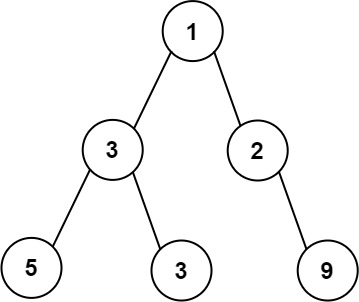Problem
Given the root of a binary tree, return **the *maximum width* of the given tree**.
The maximum width of a tree is the maximum width among all levels.
The width of one level is defined as the length between the end-nodes (the leftmost and rightmost non-null nodes), where the null nodes between the end-nodes that would be present in a complete binary tree extending down to that level are also counted into the length calculation.
It is guaranteed that the answer will in the range of a 32-bit signed integer.
Example 1:

Input: root = [1,3,2,5,3,null,9]
Output: 4
Explanation: The maximum width exists in the third level with length 4 (5,3,null,9).
Example 2:

Input: root = [1,3,2,5,null,null,9,6,null,7]
Output: 7
Explanation: The maximum width exists in the fourth level with length 7 (6,null,null,null,null,null,7).
Example 3:

Input: root = [1,3,2,5]
Output: 2
Explanation: The maximum width exists in the second level with length 2 (3,2).
Constraints:
The number of nodes in the tree is in the range
[1, 3000].-100 <= Node.val <= 100
Solution (Java)
/**
* Definition for a binary tree node.
* public class TreeNode {
* int val;
* TreeNode left;
* TreeNode right;
* TreeNode() {}
* TreeNode(int val) { this.val = val; }
* TreeNode(int val, TreeNode left, TreeNode right) {
* this.val = val;
* this.left = left;
* this.right = right;
* }
* }
*/
class Solution {
static class Pair {
TreeNode node;
int idx;
public Pair(TreeNode node, int idx) {
this.node = node;
this.idx = idx;
}
}
public int widthOfBinaryTree(TreeNode root) {
Queue<Pair> q = new LinkedList<>();
q.add(new Pair(root, 0));
int res = 1;
while (!q.isEmpty()) {
int qSize = q.size();
int lastIdx = 0;
int firstIdx = 0;
for (int i = 0; i < qSize; i++) {
Pair temp = q.poll();
if (i == 0) {
firstIdx = temp.idx;
}
if (i == qSize - 1) {
lastIdx = Objects.requireNonNull(temp).idx;
}
if (Objects.requireNonNull(temp).node.left != null) {
q.add(new Pair(temp.node.left, 2 * (temp.idx) + 1));
}
if (temp.node.right != null) {
q.add(new Pair(temp.node.right, 2 * (temp.idx) + 2));
}
}
res = Math.max((lastIdx - firstIdx) + 1, res);
}
return res;
}
}
Explain:
nope.
Complexity:
- Time complexity : O(n).
- Space complexity : O(n).